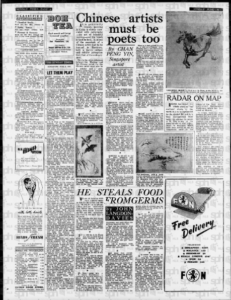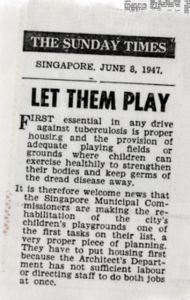In the contemporary Singaporean landscape, one expects the pleasure of pristine air, meticulously groomed parks housing vibrant playgrounds, and immaculate neighbourhoods. Yet, through a newsprint article, this discussion will explore how such a picturesque scene was not always reality.


Figure 1. The Straits Times, 8 June 1947, 1
The newspaper article titled ‘Let them Play’, printed June 8th 1947 in the Straits Times, sheds light on the challenging conditions faced by Singapore during a period of rapid urbanisation and high population density, all transpiring under the umbrella of British colonial rule.
The historical backdrop adds depth to the narrative, emphasising resilience of the Straits Times as it resumed publication after the disruption caused by the Japanese occupation during World War II. Against this backdrop, the article vividly captures the stark reality of overcrowding and the associated health challenges that plagued the city. Terms such as ‘tuberculosis,’ ‘germs,’ and ‘breeding,’ evoke a vivid picture of the public health issues intertwined with the burgeoning urban landscape. In essence, the narrative highlights the broader challenges faced by Singapore as it navigated through post-war reconstruction, urban expansion, and the complexities of colonial administration.
In the nineteenth and twentieth centuries, Singapore, like many rapidly growing urban centres, confronted the health challenges that accompanied a surge in population.2 Notably, tuberculosis emerged as a significant public health concern.3 As revealed by figure 1, there was a prevailing belief that disease could be mitigated through ‘proper housing.’ A convincing statement that is reiterated and further explored by Brenda Yeoh in her research Contesting Space in Colonial Singapore: Power Relations and the Urban Built Environment. In this book she delves into the impact of tuberculosis on public health policies, delving into the municipal responses that ensued transforming housing and sleeping conditions. Her work is a welcomed and well-respected contribution to the intersections of hygiene sanitation and the impact of disease on the transformation of housing and the lives of Singapore’s residents. This research is an invaluable insight that enriches ones understanding of Singapore’s journey towards improved health and hygiene standards.
However, this source proves invaluable as it not only complements but also extends the scope of Yeoh’s research. As Yeoh’s research illuminates the many facets of Singapore’s housing development, this source draws attention to the role of recreational spaces in also shaping Singapore’s development in health and hygiene. It notes that ‘the provision of adequate playing fields’ is just as ‘essential’ as ‘proper housing.’
Indeed, the article stresses the urgent need for ‘adequate playing fields or grounds where children can exercise healthily to strengthen their bodies and keep germs of the dread disease away.’ This conveys and understanding held that the development of playgrounds was not merely for amusement but would be a sanctuary where the vitality of Singapore’s future was to be nurtured. In the words of the article, a compelling narrative begins to take place, that the health of children was paramount for the future success of Singapore. In this source playgrounds are described as ‘lungs’ which conveys the understanding of these spaces as vital breathing grounds of the city’s health. This metaphorical framing emphasises the crucial role that playgrounds will play in allowing the city to ‘breath,’ as children will have a safer outlet for physical activity, no longer ‘cooped up in small rooms’ or playing on dangerous ‘streets.’ The powerful phrase ‘let them play’ is a symbol of the city’s commitment to better health and hygiene. This sentiment encapsulates a resounding call to action, carrying with it that children’s play was not just a pastime and therefore the idea ‘we must have these playgrounds in operation as quickly as possible,’ helps shed light on the importance of recreational spaces to the nation’s long-term success.
This article is a historical snapshot, illustrating the multifaceted dynamics of a city in transition, grappling with the consequences of rapid growth in a challenging post-war era. It highlights the role of recreational spaces as another useful tool in combating the challenge of health and hygiene.
- Figure 1. ‘Let them Play,’ The Straits Times, Singapore, 8 June 1947, p. 6 ,<https://eresources.nlb.gov.sg/newspapers/digitised/page/straitstimes19470608-1.1.6> [accessed 10 November 2023]. [↩]
- Charlotte, Furth, ‘Introduction: Hygienic Modernity in Chinese East Asia,’ in Qizi Liang, Angela Ki Che Leung, and Charlotte Furth, Health and Hygiene in Chinese East Asia: Policies and Publics in the Long Twentieth Century, (2010), p. 16 [↩]
- Brenda S. A Yeoh, Contesting Space in Colonial Singapore: Power Relations and the Urban Built Environment, (2003), p. 94 [↩]